Cat owners may find themselves concerned when they notice their feline friend’s paw pads beginning to peel. This condition can be unsettling, as paw pads are crucial for a cat’s health and mobility. Healthy paws allow cats to walk, run, and engage in their natural behaviors comfortably. Peeling can be the result of a variety of causes ranging from environmental irritants to more serious health issues. It’s essential to address peeling paw pads promptly to prevent discomfort or infection.
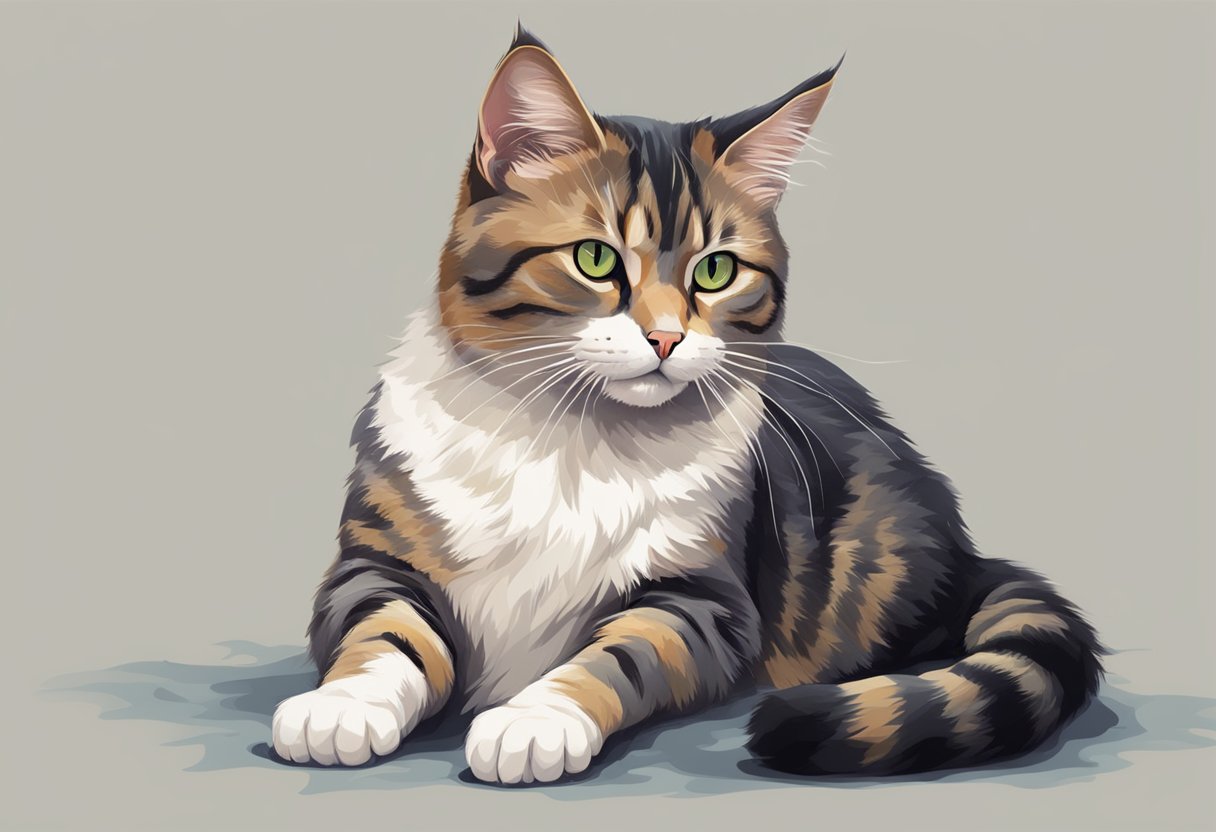
Immediate care and appropriate cleaning of the affected area are vital first steps in dealing with peeling paw pads. Treatment often involves remedies that soothe and heal the pads, whereas preventative measures can reduce the chances of recurrence. In cases where home care does not resolve the issue, a visit to the veterinarian is necessary for a professional assessment and guidance on recovery and aftercare.
Key Takeaways
- Cat paw pads may peel due to various environmental or health-related causes.
- Prompt cleaning and care are essential for treating peeling paw pads.
- A vet visit may be necessary if the condition persists or worsens.
Understanding Paw Pad Peeling
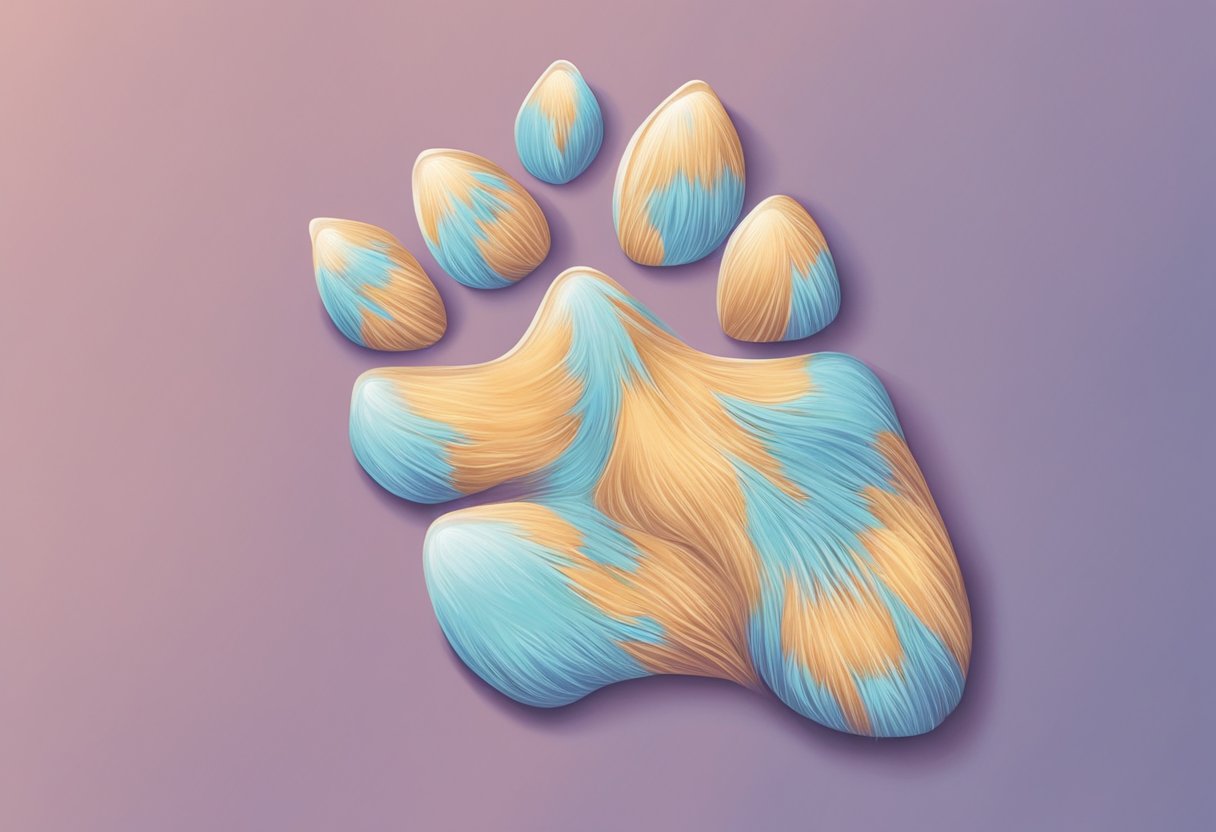
Paw pad peeling in cats is a notable symptom that can arise from various health and environmental factors. This section delves into the different causes, symptoms, and the impacts of living conditions and diet on the health of a cat’s paw pads.
Common Causes of Paw Pad Peeling
Cats’ paw pads are sensitive and can peel due to allergies, exposure to chemical irritants, nutritional deficiencies, or infections. Injury or trauma, including cuts or scrapes from running on rough surfaces, can also result in pad issues.
Symptoms Accompanying Paw Pad Issues
Peeling paws may be accompanied by redness, inflammation, or dryness. Cats may exhibit painful reactions, such as limping or excessive licking of their paws, which can indicate itchy skin or discomfort.
The Contrast between Outdoor and Indoor Cats
Outdoor cats are more susceptible to environmental factors such as hot pavement or extreme weather, which can cause paw pad issues. Indoor cats can encounter foreign objects or cleaning chemicals that may irritate their paws.
Influence of Nutrition on Paw Health
A diet lacking in essential proteins or certain vitamins can lead to nutritional deficiencies affecting paw health. Proper hydration and nutrition are crucial for maintaining healthy, resilient paw pads.
Behavioral Factors
Over-grooming behavior, often stimulated by stress or boredom, can result in hair loss and damaged paw pads. Providing a scratching post can help minimize potential injuries stemming from excessive grooming.
Identifying Injuries and Infections
Cats may hide their injuries well, but limping, blisters, or cracked skin can signal a problem. Bacterial or fungal infections may also cause paw pads to peel and should be treated promptly.
Impact of Extreme Weather Conditions
Dry air in winter or hot surfaces in summer can drastically affect a cat’s paw pads, causing dryness or blisters. It’s vital to be aware of extreme weather conditions and protect your cat’s paws accordingly.
The Role of Environmental Irritants
Cats can be allergic to various substances, with reactions leading to paw pad issues. Allergic reactions to pollen, mold, or even household cleaners can manifest as irritation on the paws.
Chronic Health Conditions and Paw Health
Autoimmune diseases or other chronic conditions like cancer or hormonal imbalances may have external manifestations, including the peeling of paw pads. Such conditions often require comprehensive medical attention.
Initial Care and Cleaning
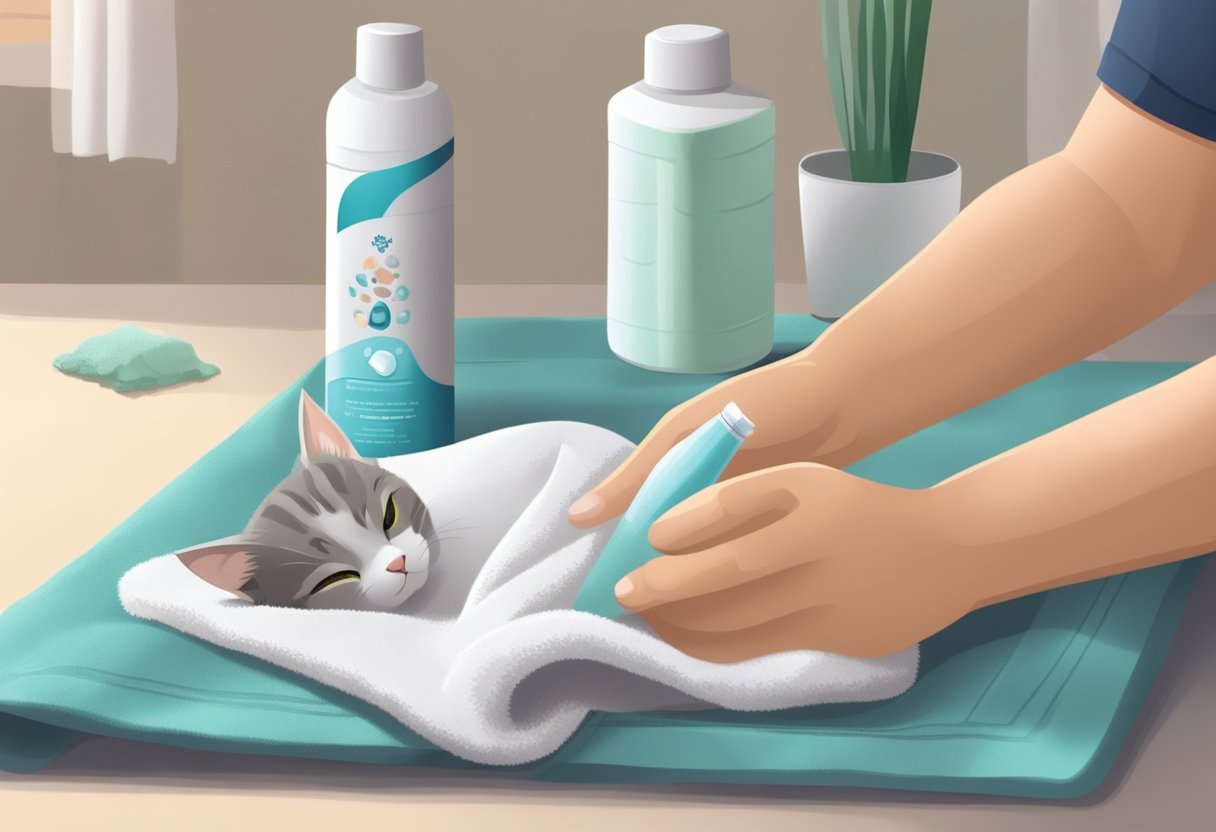
When a cat’s paw pads are peeling, it could indicate minor injuries or the beginning of an infection. Immediate attention to paw pad health involves careful cleaning and applying safe, at-home treatments to prevent complications.
Basic Paw Pad First Aid
Cat parents should inspect the paw pads for any signs of redness, cuts, blisters, or foreign objects. For superficial injuries, gently clean the affected area with a mild, pet-safe soap and warm water, then apply an antiseptic. A layer of Vaseline can be used to protect a minor cut or abrasion from dirt. If redness or swelling persists, it’s advisable to seek veterinary care as it may be a sign of infection.
Home Cleaning Solutions
- Coconut oil: A natural moisturizer, it can soothe dry paw pads. Apply a small amount after cleaning to nourish the skin.
- Aloe vera gel: This has cooling and healing properties. Use pure gel on clean, dry paw pads to alleviate irritation.
- Apple cider vinegar: Dilute with water for a disinfecting wash if there are no open wounds, as it could sting and cause discomfort.
- Epsom salt bath: Soak your cat’s feet in an Epsom salt and warm water solution to help heal blisters or minor wounds.
- Olive oil and castor oil: Use sparingly, as these can help moisturize but may cause issues if ingested in larger amounts by your cat during grooming.
Treatment and Remedies for Peeling Paw Pads
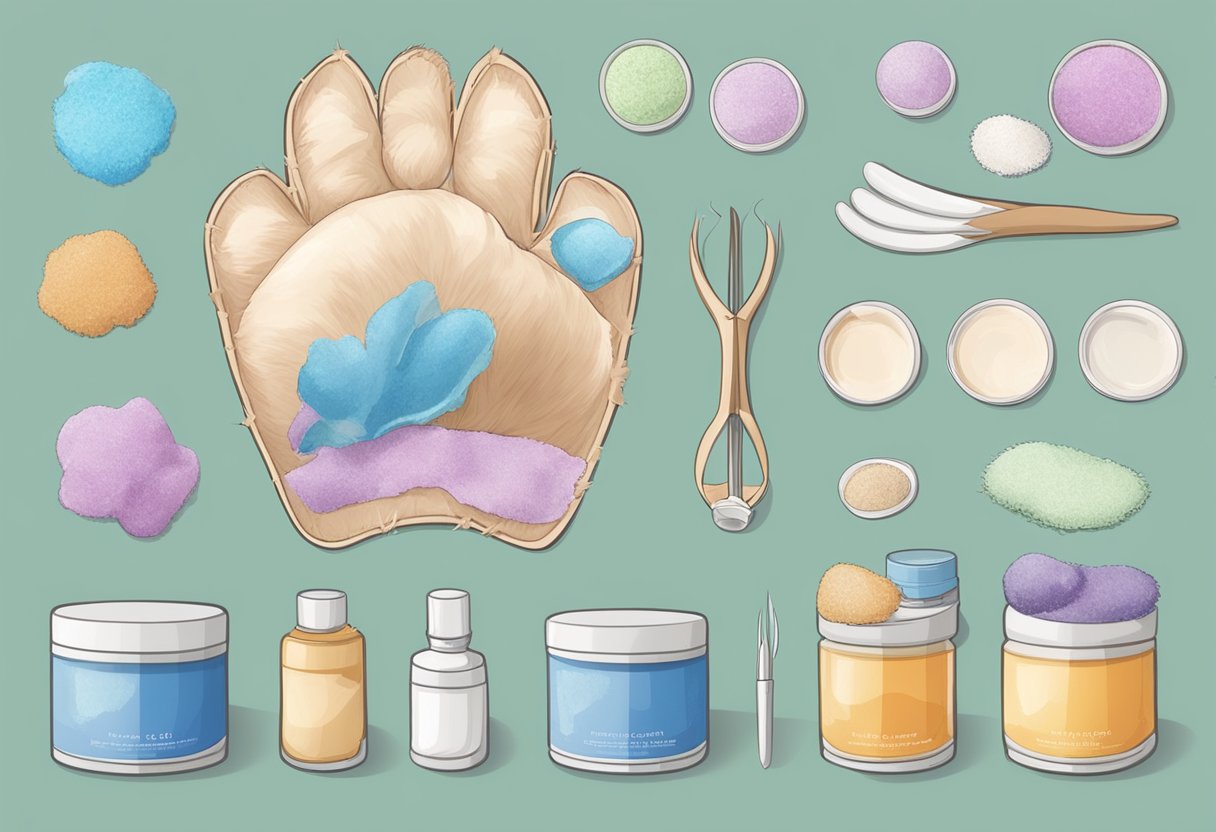
When a cat’s paw pads are peeling, it can be a sign of underlying issues such as allergies, infections, or exposure to harsh chemicals. Timely and appropriate treatment is crucial to alleviate redness, inflammation, and prevent infection, ensuring proper hydration and moisture of the cat’s paws. Here are specific treatments and home remedies that one may consider.
Over-the-Counter Treatments
- Antibiotics and Anti-inflammatories: For bacterial infections causing paw pad peeling, veterinarians may prescribe oral or topical antibiotics. If the peeling is accompanied by inflammation, anti-inflammatory medications can help reduce swelling and discomfort.
- Moisturizers: Specialized pet-safe moisturizers designed for paw pads can provide much-needed hydration. Products containing ingredients like Vaseline or fish oil can assist in healing and protect pads from further damage.
Natural and Home Remedies
- Aloe Vera Gel: Applying aloe vera gel can soothe and cool red, inflamed paw pads, due to its natural healing properties. It must be free of additives that can be toxic to cats if ingested.
- Oils: Natural oils like coconut oil, olive oil, and fish oil are excellent for moisturizing dry, cracked paw pads. They are safe for cats and can also be ingested in small amounts during grooming.
- Apple Cider Vinegar: For a mild fungal infection, diluted apple cider vinegar can act as a natural antifungal agent, but one must ensure it does not sting if the pads are excessively raw.
Remember, before administering any treatment or home remedy, it is advisable to seek professional advice from a veterinarian to ensure safety and suitability for your cat’s specific condition.
Preventative Measures and Maintenance
Proper care and attention can prevent most issues related to cat paw pad peeling. These measures encompass various methods, from dietary adjustments to behavioral and environmental management.
Paw Pad Moisturizing Techniques
Routine moisturizing can keep paw pads supple and healthy. Pet-safe balms or natural oils, such as coconut oil or olive oil, can be applied to your cat’s paw pads to combat dryness. Avoid using products like Vaseline which are not intended for ingestion, as cats often lick their paws.
Appropriate Outdoor Protection
When allowing a cat outside, protective gear such as booties can prevent paw injuries from hot or cold surfaces. This is particularly crucial in extreme weather to protect against burns or frostbite.
Adjusting Indoor Environments
Dry air indoors can affect a cat’s paw pads. Using a humidifier can help balance the moisture level in the environment, making it more conducive to maintaining healthy paw pads for indoor cats.
Nutritional Considerations for Paw Health
A diet that includes proper nutrition is vital for healthy paw pads. Sufficient protein and fish oil can provide essential fatty acids that promote paw health. Nutritional deficiencies can lead to peeling paw pads, so one should consider a diet that supports overall skin health.
Behavior Modification and Stress Management
Peeling paw pads may be an outcome of stress or overgrooming behavior. Recognizing and reducing stressors in the environment, coupled with providing adequate outlets for natural behaviors, can alleviate these issues.
Regular Paw Inspections and Nail Trimming
Owners should conduct regular paw inspections for signs of injury or foreign objects, which can exacerbate peeling. Additionally, nail trimming is necessary to prevent overgrowth that can cause discomfort and subsequent harmful behaviors.
When to See a Veterinarian
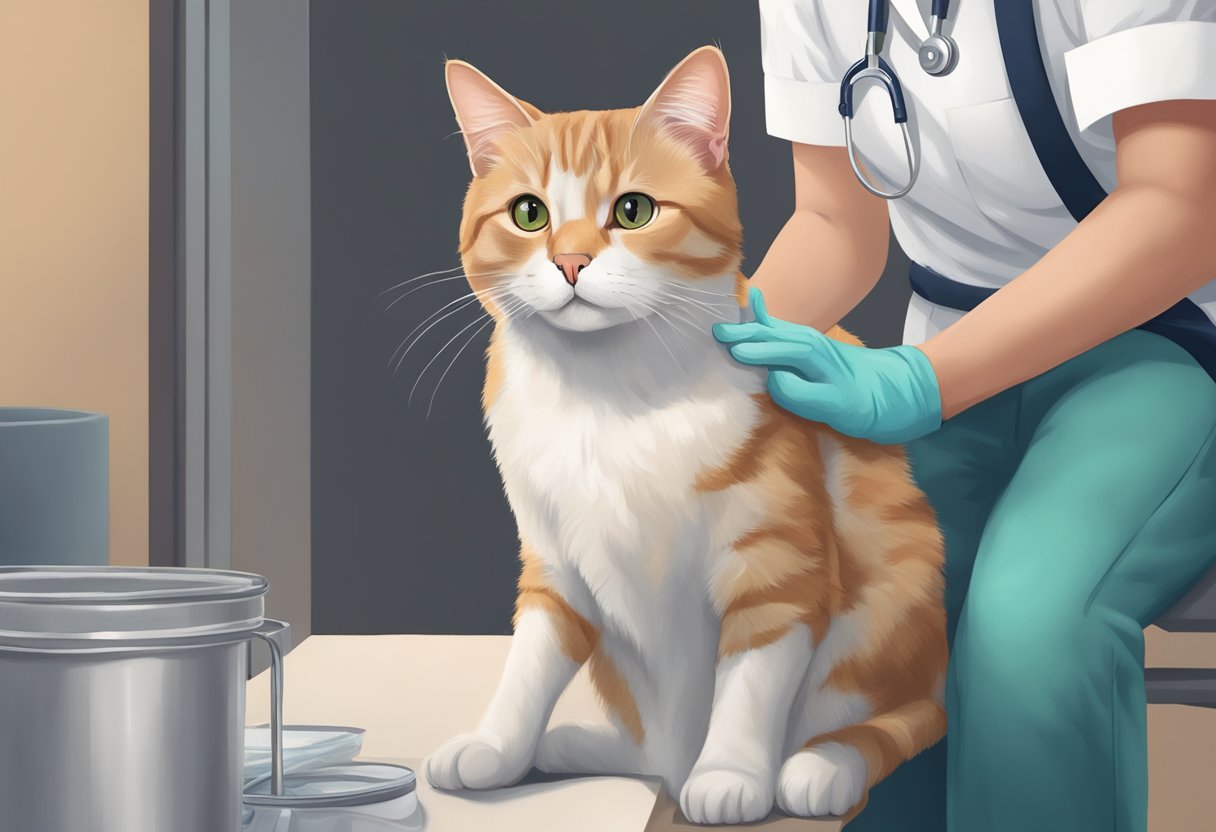
When a cat’s paw pads are peeling, it could be a symptom of a minor issue or an indication of a more serious health concern. It is important to assess the situation carefully and determine if veterinary attention is necessary.
Determining the Severity of Paw Issues
If a cat exhibits signs of discomfort, such as limping or excessive licking of its paws, it may suggest the peeling is causing pain. Owners should inspect the paws for signs of injury, burns, or trauma. Any noticeable wounds or severe peeling warrant immediate veterinary consultation.
Potential Need for Medical Intervention
Medical intervention may be required if there are signs of infection such as swelling, redness, or discharge. A veterinarian can provide appropriate treatment, including medications such as antibiotics for bacterial infections or antifungal treatments for fungal infections. In more severe cases, surgery might be necessary.
Health Conditions Requiring Professional Diagnosis
Several health conditions, including autoimmune diseases, cancer, hormonal imbalances, or allergic reactions, may manifest symptoms that include the peeling of paw pads. A professional diagnosis is essential in these instances, as these issues require specific treatments.
Monitoring and Managing Chronic Conditions
Chronic conditions such as nutritional deficiencies or allergies may lead to recurrent paw pad peeling. Regular veterinary check-ups are important to manage these conditions effectively. Adjustments to diet or environment may be part of a long-term management plan advised by a veterinarian.
Recovery and Aftercare Following Treatment
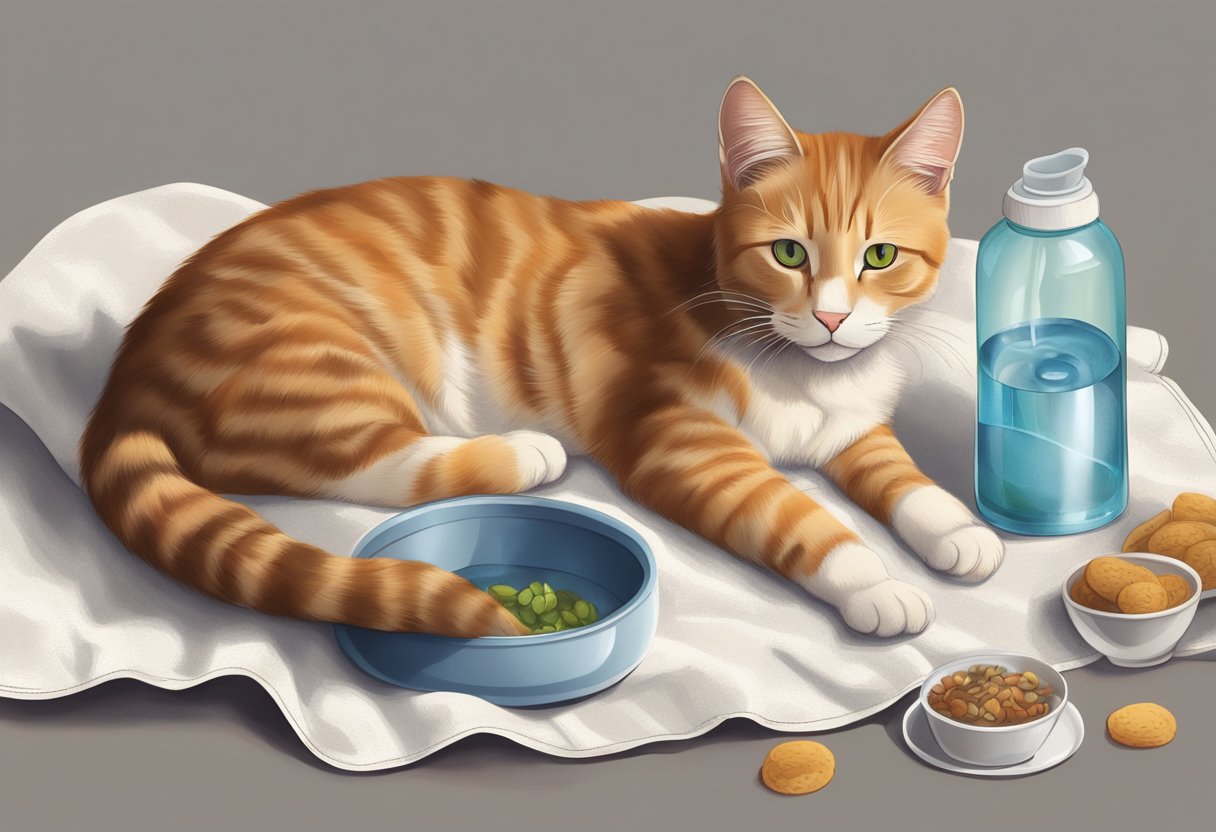
Following treatment for peeling paw pads, the focus shifts to supporting the cat’s healing process and ensuring a safe and stress-free recovery. A diligent aftercare routine is integral to prevent re-injury and promote paw health.
Post-Treatment Paw Care
Healing: Once a veterinarian has addressed the underlying cause of paw pad peeling, the cat’s paws will begin the healing process. Close monitoring is critical to detect any signs of infection or complications early. The owner should ensure the cat’s paws remain clean and dry to avoid hindrance to the healing tissue.
Stress Management: Cats require a calm environment to recover without added stress that could provoke further licking or biting of their paws. The cat’s living space should be quiet and comfortable, away from loud noises or frequent disturbances.
Moisturizing: Applying a vet-recommended moisturizer can help restore hydration to the cat’s paw pads, but it’s important that the product is safe if ingested. This should be done with care, adhering strictly to the directions provided by the veterinarian.
Hydration: Adequate hydration is essential for overall health and aids the recovery of the skin. Owners should ensure their cat has continuous access to fresh water.
Protection: Cats may sometimes require protective coverings on their feet to prevent direct contact with surfaces that could damage the delicate healing tissue. Owners should use these coverings as advised by the veterinarian.
Environment: Optimizing the cat’s environment to remove potential irritants that could further damage paw pads or disrupt the healing process is necessary. This can include checking that floors are clean of chemical residues and ensuring that litter is non-irritating to sensitive paws.
Conclusion
Keeping healthy paws is vital for a cat’s overall well-being. Peeling paw pads may signal a range of issues that require attention. These issues include environmental factors, such as rough terrains or hot surfaces, and internal health problems like allergies or infections.
First, pet owners should inspect the living environment of their feline companions. A dry environment could cause a lack of moisture leading to peeling paw pads. Conversely, exposure to harsh chemicals from certain cleaners can also be problematic. For outdoor cats, hot pavement or rocky landscapes could be responsible for the damage.
In cases where an external cause is not immediately evident, it’s possible that the cat is experiencing an allergic reaction or suffering from an infection, either bacterial or fungal. Another less common affliction to consider is plasma cell pododermatitis, a disease affecting the paw pads.
Caretakers should remain proactive by regularly examining their cat’s paw pads for signs of peeling. Prompt detection coupled with veterinary consultation can ensure the swift treatment of any underlying health issues. Maintaining paw pad health is not only critical for a cat’s comfort but also for its mobility and quality of life.
Frequently Asked Questions
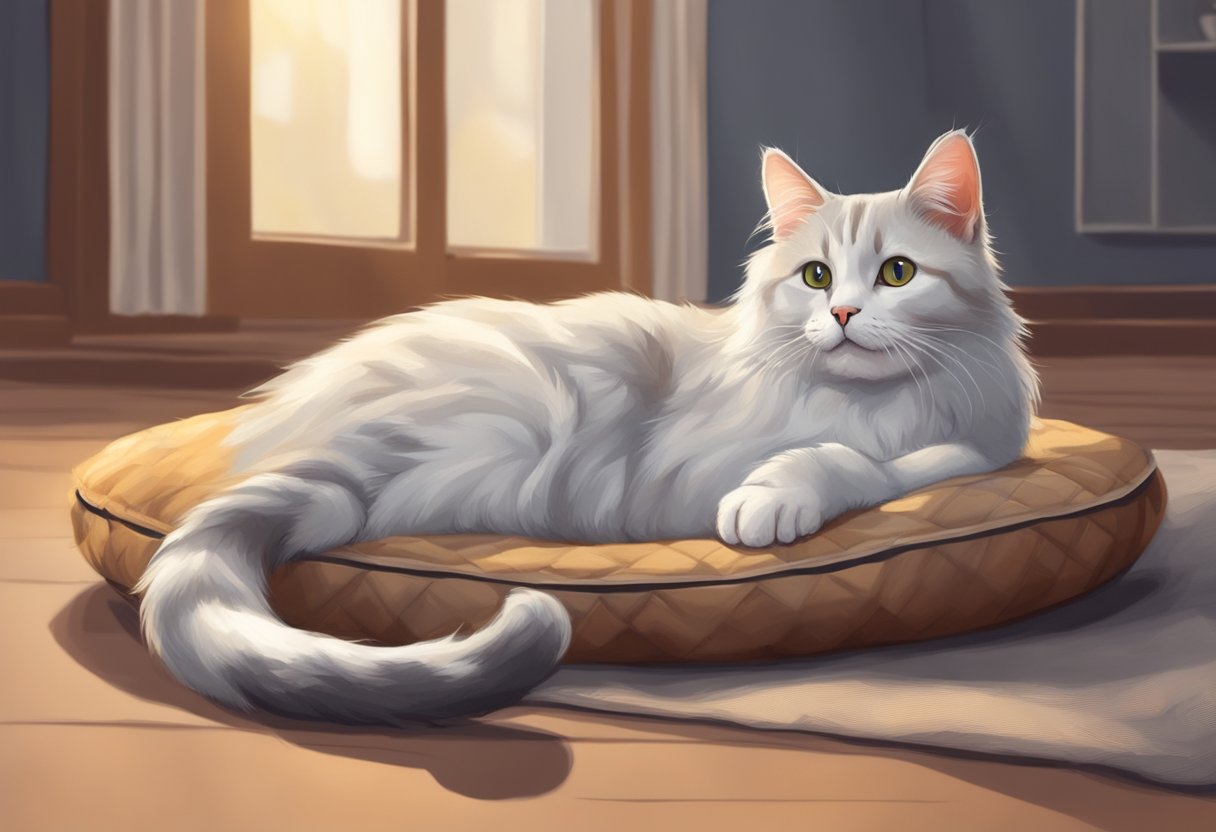
When it comes to the health and care of a cat’s paws, owners commonly have questions about causes and treatments for peeling pads. This FAQ section aims to address those concerns with accurate information.
What causes paw pad peeling in cats?
Peeling of the paw pads in cats can be attributed to various factors, such as walking on rough surfaces, allergies, burns, infections, or underlying health problems. Detailed information on the conditions that lead to peeling can be found in this discussion on paw pad peeling.
How can I treat my cat’s injured paw pad at home?
Minor injuries to a cat’s paw pad can often be treated at home with gentle cleaning and keeping the affected area protected. However, it’s essential to identify the severity before deciding to treat it at home, and homeowners should seek advice for home treatment when uncertainty arises.
What are the best practices for preventing dry and cracked paw pads in cats?
To prevent cats’ paw pads from becoming dry and cracked, owners should ensure their pet’s environment is safe from harsh chemicals, avoid excessive exposure to hot surfaces, and provide regular paw inspections. For more preventative tips, owners can examine these best practices.
How do I identify and treat pillow foot in cats?
Pillow foot, or pododermatitis, is identified by swollen, soft, and sometimes ulcerated paw pads. Treatment typically involves antibiotics or anti-inflammatories prescribed by a veterinarian, and understanding pillow foot can help in early detection and care.
What should I do if my cat’s paw pad is bleeding?
If a cat’s paw pad is bleeding, it’s crucial to gently clean the wound with an antiseptic and apply light pressure with a clean cloth to stop the bleeding. Following first aid, a veterinarian should evaluate the injury to prevent infection and facilitate healing.
When should I seek veterinary attention for my cat’s paw pad issues?
Veterinary attention is advised when a cat’s paw pad is severely injured, does not heal, or if there are signs of infection or an underlying health condition causing the peeling pads. Timely attention from a vet is critical and can often be the best course of action for paw pad issues.
